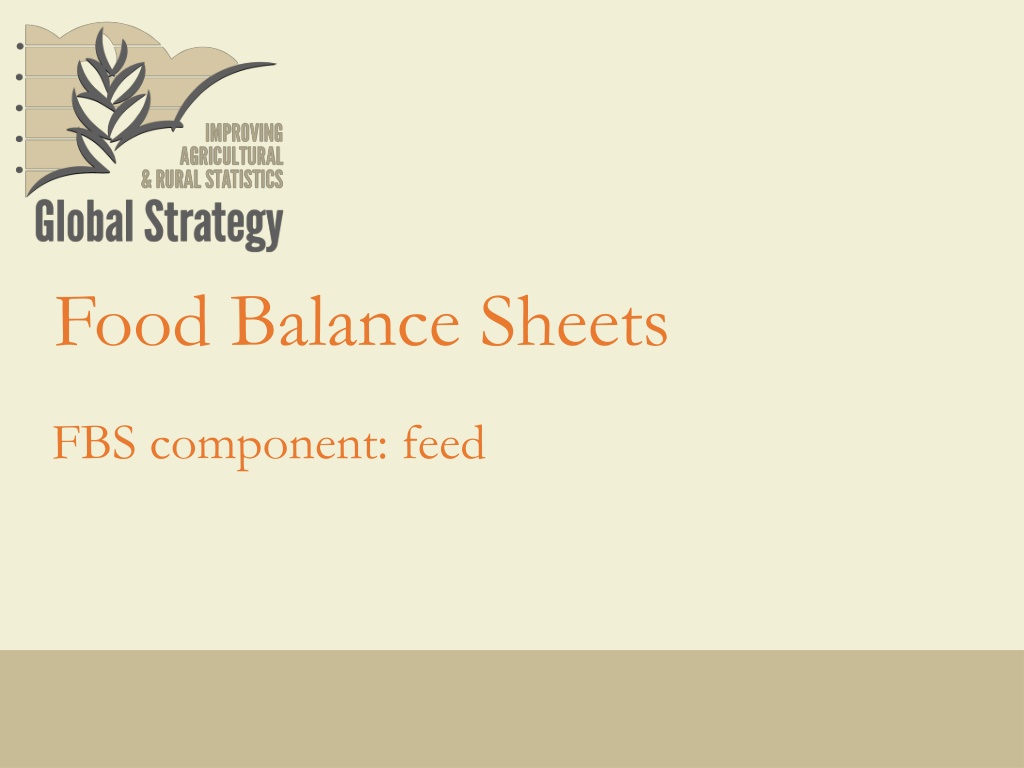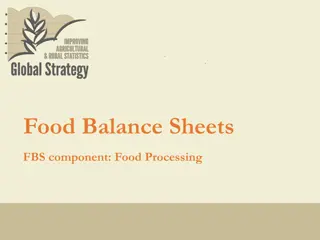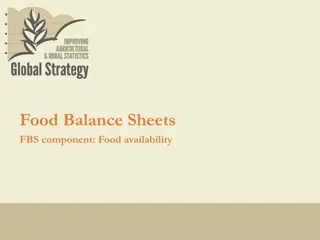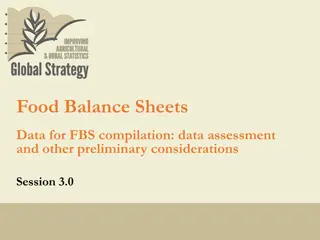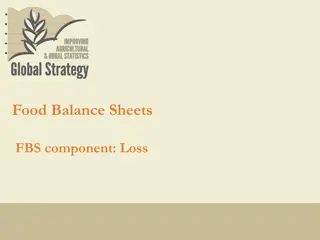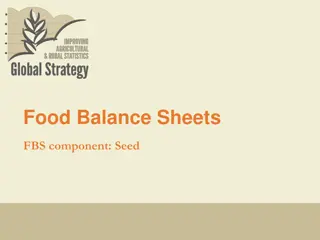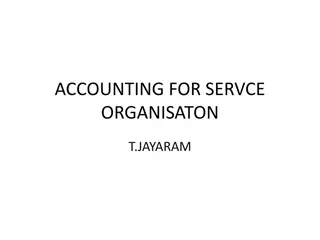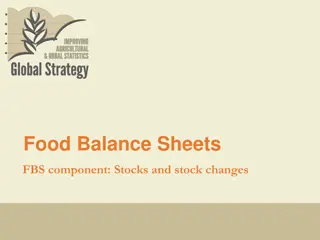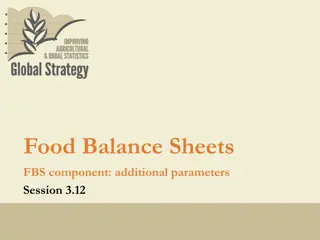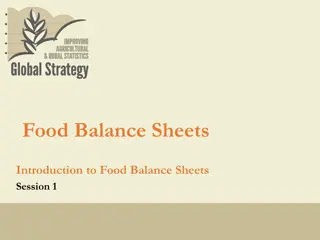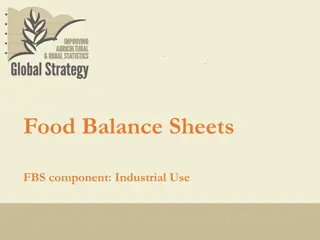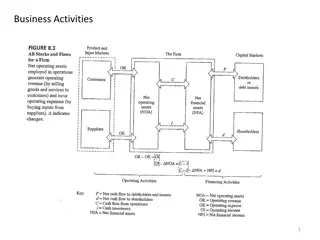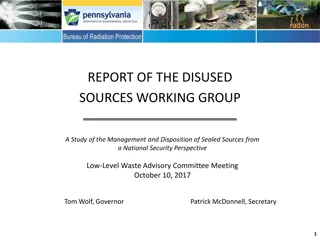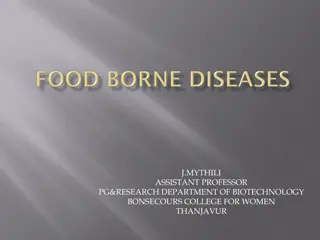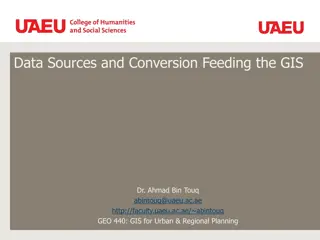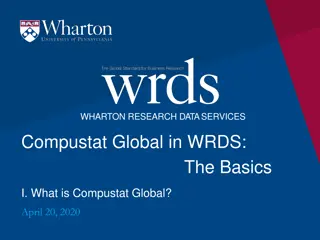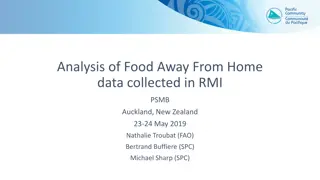Understanding Food Balance Sheets: Data Sources and Imputation
Explore the world of food balance sheets, focusing on data sources for feed and recommended approaches for imputation and estimation. Discover definitions, official and alternative data sources, and the importance of cross-checking feed production with livestock demands.
Download Presentation

Please find below an Image/Link to download the presentation.
The content on the website is provided AS IS for your information and personal use only. It may not be sold, licensed, or shared on other websites without obtaining consent from the author. Download presentation by click this link. If you encounter any issues during the download, it is possible that the publisher has removed the file from their server.
E N D
Presentation Transcript
Food Balance Sheets FBS component: feed
Learning Objectives At the end of this session, the audience will know: a) Different data sources for feed b) Recommended approach for Imputation and estimation of feed 2
Outline 1. Definitions 2. Data sources 3. Imputation and Estimation 3 3
Definitions 4 4
Definition Feed =quantities of commodities both domestically produced and imported that are available for feeding to livestock. Many commodities that are used as feed are byproducts of industrial processes(examples oilcake, dregs, or distiller s dried grains with solubles (DDGS)) While they are included in initial calculations most will not be aggregated up to the primary commodity level in order to avoid double counting. 5 5
Data sources 6 6
Data Sources Official data sources Feed can be sourced from a variety of actors. Thus, having an accurate picture of aggregate feed production can require various types of surveys Questions can be added to farm-level surveys about own production reserved for feed, . feed compounders can be surveyed as to their output, and . pasture resources can be estimated using a variety of methods. . If feed compounders are not surveyed, it may also be possible to derive an estimate of their output by consulting administrative records . 7 7
Data Sources Official data sources It is important that this official data on feed production be cross-checked against actual livestock feed demands, in terms of both total energy and total protein requirements. 8 8
Data Sources Alternative data sources And if official data are incomplete or not available? Some unofficial data sources may also exist. Estimates of quantity or proportion Commodity interest groups can either have some measurement or estimate of the quantity or proportion of their particular commodity that is being used as animal feed. Livestock associations At the same time, livestock associations may publish data on feed usage, or may be able to at least provide some indication as to the composition of feed rations for certain animal groups 9 9
Imputation and estimation 10 10
Imputation and estimation the general approach recommended here is based on the reconciliation of aggregate feed demand and available feed supply. Two basic steps are recommended in this process 11 11
Imputation and estimation Step 1: Understanding and estimating total feed demand Total feed demand is at its most basic level merely a function of : the total number of animals and the nutritional needs of those animals, both in terms of total energy and protein. Expression of Feed demand, FD: ?? = ??? ?? N= number of animals e= energy required per animal 12 12
Imputation and estimation Step 1: Understanding and estimating total feed demand amount of energy required per animal can vary widely even within species, depending upon both : the characteristics of the animal and the type of the production system in which the animal is raised this imputation method estimates feed demand only for non-forage commodities At the same time, the supply of forage crops are necessary for the calculation of total feed supply under this method 13 13
Imputation and estimation Step 1: Understanding and estimating total feed demand Some factors should be taken into consideration in order to accurately estimate feed demand: Understand the different livestock production systems in practice in the country for each species With the assistance of farm surveys and censuses, attempt to estimate the number of animals for each animal species raised in the country Determine the average animal s feed requirements for each production system 14 14
Imputation and estimation Step 1: Understanding and estimating total feed demand If data on the number of animals raised under different production systems is of good quality, consider estimating the feed needs of animals raised under separate production systems as if they were a different species Sum the feed needs of all animal species, both in terms of energy and protein 15 15
Imputation and estimation Step 2: Understanding and allocating feed supply Key steps An inventory of all of the products that are potentially used for feed in the country An analysis or ranking of which commodities are most likely to be used for feed demand Analysts should keep in mind the fact that many byproducts from food processing such as bran or fruit pulp can be assumed to be utilized exclusively as feed in the FBS setting 16 16
Imputation and estimation Step 3: Allocating feed supply The final step is to allocate the remaining feed demand to available commodities. The recommended approach of doing so is to assemble a technical working group to discuss the most likely feed commodities, and distribute feed demand amongst them accordingly. Alternatively, FBS compilers can use whatever information is gathered in the initial feed inventory at the beginning of Step 2, and allocate feed demand accordingly based on the ranking of which commodities are most likely to be used as feed 17 17
References 3rdChapter of the guideline:, Data for FBS compilation: considerations, sources and imputation , 3.5.6 Feed 18 18
